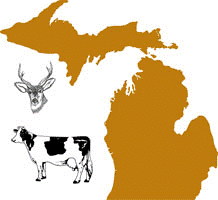Wildlife Disease and Zoonotics
Date of this Version
6-24-2008
Abstract
In July 2005, a Minnesota beef herd tested positive for Mycobacterium bovis (M. bovis) and was officially declared infected with bovine tuberculosis (TB). This was the first infected herd identified since Minnesota’s Accredited Free (AF) status was obtained in 1976. Subsequent testing identified infection in white-tailed deer and several cattle herds adjacent to this index herd. In February 2008, Minnesota declared its 11th infected cattle herd, resulting in the downgrade of the entire State’s TB status to Modified Accredited (MA).
In an effort to minimize the impact of MA status to the State and producers, Minnesota initiated the process for split-State status application. Minnesota is currently in the process of writing its final application, but has submitted a proposed plan to the United States Department of Agriculture’s (USDA) Animal and Plant Health Inspection Service (APHIS) Veterinary Services (VS) for review. The Risk Analysis Team at USDA:APHIS:VS Centers for Epidemiology and Animal Health (CEAH) was asked by the VS Eastern Region office to conduct a risk assessment of Minnesota’s proposed plan for split-State status. In its plan, Minnesota outlines an area containing 300 cattle herds to be designated the MA zone. In addition, Minnesota is proposing the rest of the State be considered Accredited Free.
The objectives of this assessment are:
1. To determine if there is sufficient evidence to demonstrate the absence of M. bovis in cattle and other potential hosts in the proposed AF zone; and
2. To evaluate the adequacy of Minnesota’s proposed plan to:
a. Prevent the future release of M. bovis from the proposed MA zone; and
b. Detect the future introduction of M. bovis in the proposed AF zone.
The three major risk pathways evaluated for transmission of M. bovis out of the proposed MA zone were: (1) the movement of cattle; (2) the movement of potentially infected white-tailed deer and other wildlife; and (3) the movement of potentially M. bovis-contaminated feed and other fomites.
In addition, the following questions were discussed:
1. Is active transmission of M. bovis still occurring in white-tailed deer or cattle in the proposed MA zone?
2. Are all identified areas of high risk currently contained within the proposed MA zone?
3. Is Minnesota’s plan for split-State status sufficient to mitigate all risk pathways for future transmission of M. bovis outside the proposed MA zone?
4. Has adequate sampling been conducted in the proposed AF zone to demonstrate livestock and wildlife are not at risk of being infected with M. bovis?
5. Are future surveillance efforts in the proposed AF zone sufficient to demonstrate the design prevalence required in 9 CFR 77, based on potential risks in that zone?
6. Does the State have the necessary financial resources to implement and enforce the proposed split-State plan?



Comments
Published by USDA-APHIS.